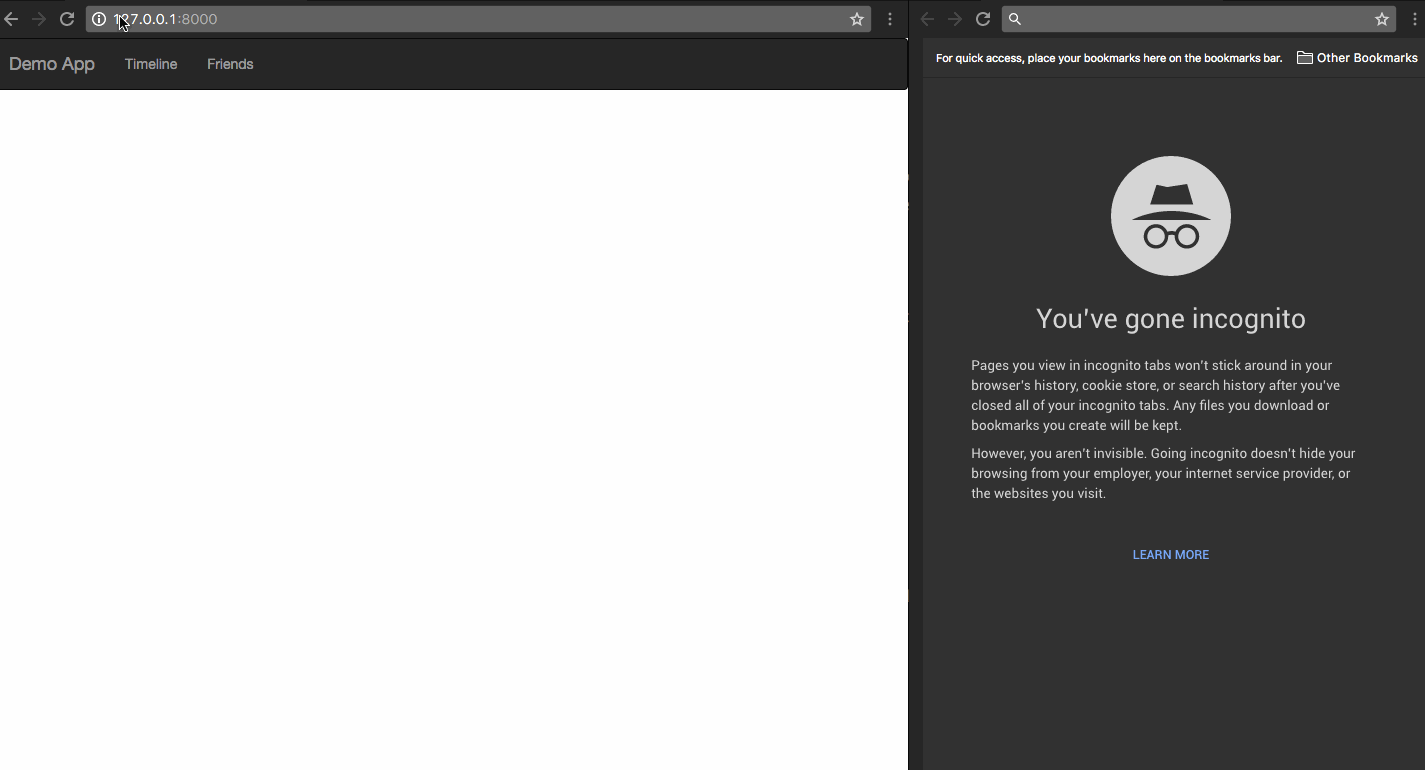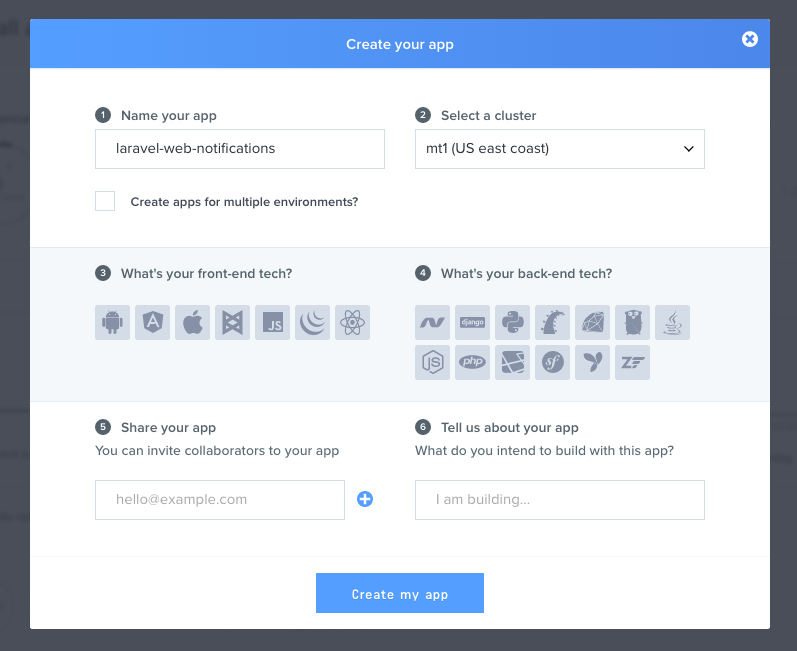许多Web应用程序都包括应用内通知系统,当有人执行与您或您的帐户相关的操作时,该系统会立即通知您。在Facebook上,当有人喜欢你的状态或有人对你的个人资料发表评论时,你会收到通知。本教程将通过使用Laravel和Pusher.)创建基于Web的通知系统来指导您复制此功能
前提条件
要学习本教程,您需要在您的计算机上安装PHP和Laravel,以及一个Pusher帐户。
我们要建造的
在本教程之后,我们将演示如何让一个小型Web应用程序使用Laravel和Pusher显示通知。这将类似于Facebook等网站显示通知的方式。以下是我们将建设的项目的预览:
 的浏览器的动画gif
的浏览器的动画gif
设置推流应用
创建推送帐号,,如果您尚未创建推送帐号,然后设置您的应用程序,如下面的截图所示。

设置您的Laravel应用
通过在您的终端中运行以下命令来创建新的Laravel应用程序:
1laravel new laravel-web-notifications
之后,使用Composer安装Pusher PHP SDK。运行以下命令:
1composer require pusher/pusher-php-server
Composer完成后,下一步是配置Laravel使用Pusher作为其广播驱动程序。为此,打开Laravel安装根目录中的.env文件。更新值以匹配以下配置:
1PUSHER_APP_ID=322700
2 BROADCAST_DRIVER=pusher
3
4 // Get the credentials from your pusher dashboard
5 PUSHER_APP_ID=XXXXX
6 PUSHER_APP_KEY=XXXXXXX
7 PUSHER_APP_SECRET=XXXXXXX
重要提示:如果您使用的是EU 或** AP** 集群,请确保更新config/Broadcast ing.php配置中的选项数组,因为Laravel默认使用US服务器。您可以使用Pusher PHP库支持的所有选项。
打开``App\Providers\BroadcastServiceProvider::class./app.php并取消注释
创建Laravel和Pusher应用程序
既然配置步骤已经完成,接下来就可以创建应用程序了。首先创建一个Event类,它将从我们的Laravel应用程序广播到Pusher。可以从应用程序中的任何位置激发事件。
1php artisan make:event StatusLiked
这将在app/Events目录中创建一个新的StatusLiked类。打开该文件的内容并更新为以下内容:
1<?php
2
3namespace App\Events;
4
5use Illuminate\Queue\SerializesModels;
6use Illuminate\Foundation\Events\Dispatchable;
7use Illuminate\Broadcasting\InteractsWithSockets;
8use Illuminate\Contracts\Broadcasting\ShouldBroadcast;
9
10class StatusLiked implements ShouldBroadcast
11{
12 use Dispatchable, InteractsWithSockets, SerializesModels;
13
14 public $username;
15
16 public $message;
17
18 /**
19 * Create a new event instance.
20 *
21 * @return void
22 */
23 public function __construct($username)
24 {
25 $this->username = $username;
26 $this->message = "{$username} liked your status";
27 }
28
29 /**
30 * Get the channels the event should broadcast on.
31 *
32 * @return Channel|array
33 */
34 public function broadcastOn()
35 {
36 return ['status-liked'];
37 }
38}
ShouldBroadcast接口告诉Laravel这个事件应该使用配置文件中设置的任何驱动程序进行广播。
还有一个构造函数,它接受两个参数:用户名和动词。这些变量被分配给以相同方式命名的类特性。请务必将属性的可见性设置为PUBLIC ;否则,该属性将被忽略。
最后,设置要广播的频道名称。
创建应用程序视图
本教程将使用带有导航栏和通知图标的单个视图。当有新的通知可用时,图标将会更新,而无需刷新页面。在本教程中,通知在设计上是短暂的;如果愿意,您可以扩展该功能,并在页面重新加载后使其持续更长时间。
打开欢迎.blade.php文件,并将其替换为下面的HTML。
1<!DOCTYPE html>
2<html lang="en">
3 <head>
4 <meta charset="utf-8">
5 <meta http-equiv="X-UA-Compatible" content="IE=edge">
6 <meta name="viewport" content="width=device-width, initial-scale=1">
7 <title>Demo Application</title>
8 <link rel="stylesheet" href="//maxcdn.bootstrapcdn.com/bootstrap/3.3.7/css/bootstrap.min.css" integrity="sha384-BVYiiSIFeK1dGmJRAkycuHAHRg32OmUcww7on3RYdg4Va+PmSTsz/K68vbdEjh4u" crossorigin="anonymous">
9 <link rel="stylesheet" type="text/css" href="/css/bootstrap-notifications.min.css">
10 <!--[if lt IE 9]>
11 <script src="https://oss.maxcdn.com/html5shiv/3.7.3/html5shiv.min.js"></script>
12 <script src="https://oss.maxcdn.com/respond/1.4.2/respond.min.js"></script>
13 <![endif]-->
14 </head>
15 <body>
16 <nav class="navbar navbar-inverse">
17 <div class="container-fluid">
18 <div class="navbar-header">
19 <button type="button" class="navbar-toggle collapsed" data-toggle="collapse" data-target="#bs-example-navbar-collapse-9" aria-expanded="false">
20 <span class="sr-only">Toggle navigation</span>
21 <span class="icon-bar"></span>
22 <span class="icon-bar"></span>
23 <span class="icon-bar"></span>
24 </button>
25 <a class="navbar-brand" href="#">Demo App</a>
26 </div>
27
28 <div class="collapse navbar-collapse">
29 <ul class="nav navbar-nav">
30 <li class="dropdown dropdown-notifications">
31 <a href="#notifications-panel" class="dropdown-toggle" data-toggle="dropdown">
32 <i data-count="0" class="glyphicon glyphicon-bell notification-icon"></i>
33 </a>
34
35 <div class="dropdown-container">
36 <div class="dropdown-toolbar">
37 <div class="dropdown-toolbar-actions">
38 <a href="#">Mark all as read</a>
39 </div>
40 <h3 class="dropdown-toolbar-title">Notifications (<span class="notif-count">0</span>)</h3>
41 </div>
42 <ul class="dropdown-menu">
43 </ul>
44 <div class="dropdown-footer text-center">
45 <a href="#">View All</a>
46 </div>
47 </div>
48 </li>
49 <li><a href="#">Timeline</a></li>
50 <li><a href="#">Friends</a></li>
51 </ul>
52 </div>
53 </div>
54 </nav>
55
56 <script src="//cdnjs.cloudflare.com/ajax/libs/jquery/2.1.4/jquery.min.js"></script>
57 <script src="//js.pusher.com/3.1/pusher.min.js"></script>
58 <script src="//maxcdn.bootstrapcdn.com/bootstrap/3.3.7/js/bootstrap.min.js" integrity="sha384-Tc5IQib027qvyjSMfHjOMaLkfuWVxZxUPnCJA7l2mCWNIpG9mGCD8wGNIcPD7Txa" crossorigin="anonymous"></script>
59
60 <script type="text/javascript">
61 var notificationsWrapper = $('.dropdown-notifications');
62 var notificationsToggle = notificationsWrapper.find('a[data-toggle]');
63 var notificationsCountElem = notificationsToggle.find('i[data-count]');
64 var notificationsCount = parseInt(notificationsCountElem.data('count'));
65 var notifications = notificationsWrapper.find('ul.dropdown-menu');
66
67 if (notificationsCount <= 0) {
68 notificationsWrapper.hide();
69 }
70
71 // Enable pusher logging - don't include this in production
72 // Pusher.logToConsole = true;
73
74 var pusher = new Pusher('API_KEY_HERE', {
75 encrypted: true
76 });
77
78 // Subscribe to the channel we specified in our Laravel Event
79 var channel = pusher.subscribe('status-liked');
80
81 // Bind a function to a Event (the full Laravel class)
82 channel.bind('App\\Events\\StatusLiked', function(data) {
83 var existingNotifications = notifications.html();
84 var avatar = Math.floor(Math.random() * (71 - 20 + 1)) + 20;
85 var newNotificationHtml = `
86 <li class="notification active">
87 <div class="media">
88 <div class="media-left">
89 <div class="media-object">
90 <img src="https://api.adorable.io/avatars/71/`+avatar+`.png" class="img-circle" alt="50x50" style="width: 50px; height: 50px;">
91 </div>
92 </div>
93 <div class="media-body">
94 <strong class="notification-title">`+data.message+`</strong>
95 <!--p class="notification-desc">Extra description can go here</p-->
96 <div class="notification-meta">
97 <small class="timestamp">about a minute ago</small>
98 </div>
99 </div>
100 </div>
101 </li>
102 `;
103 notifications.html(newNotificationHtml + existingNotifications);
104
105 notificationsCount += 1;
106 notificationsCountElem.attr('data-count', notificationsCount);
107 notificationsWrapper.find('.notif-count').text(notificationsCount);
108 notificationsWrapper.show();
109 });
110 </script>
111 </body>
112</html>
这是一个很大的代码去了,但重要的部分是JavaScript部分。包括Pusher JavaScript库,然后是推送通知的javascript块。以下是JavaScript代码块中的重要代码片段:
1// Enable pusher logging - don't include this in production
2// Pusher.logToConsole = true;
3
4// Initiate the Pusher JS library
5var pusher = new Pusher('API_KEY_HERE', {
6 encrypted: true
7});
8
9// Subscribe to the channel we specified in our Laravel Event
10var channel = pusher.subscribe('status-liked');
11
12// Bind a function to a Event (the full Laravel class)
13channel.bind('App\\Events\\StatusLiked', function(data) {
14 // this is called when the event notification is received...
15});
<$>[备注] 注意: :默认情况下,Laravel会使用事件的类名来广播事件。但是,您可以通过在事件上定义广播AS方法来自定义广播名称:
1public function broadcastAs() {
2 return 'event-name';
3}
<$>
上面的代码初始化Pusher JS库并订阅一个频道。然后,当在该频道上接收到广播的事件时,它设置一个回调来调用。
测试设置
最后,要测试此设置,请创建一个手动调用该事件的路由。如果一切正常,则每当到达该路由时都会出现新的通知。让我们添加新的路由:
1Route::get('test', function () {
2 event(new App\Events\StatusLiked('Someone'));
3 return "Event has been sent!";
4});
现在使用Laravel启动一个PHP服务器,以测试代码是否正常工作:
1$ php artisan serve
结论
在本教程中,您利用Pusher的强大功能,用相对较少的代码创建了一个现代的Web通知系统。这个功能是使用Pusher可以完成的许多事情中的一个小示例。这个示例是您可以使用Pusher构建的许多可能的工具之一。
代码可在GitHub.上找到